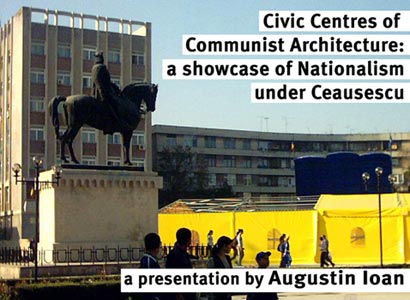
Friday 2 November 2007 – CULTURE POWER PRESENTATION: ‘Civic Centres of Communist Architecture: a showcase of Nationalism under Ceausescu’ by Augustin Ioan
18.30-20.30, The Romanian Cultural Centre, 8th floor, 54-62 Regent Street, London W1B 5RE; Tel. 020 7439 4052, ext 108; e-mail: mail@ratiufamilyfoundation.com; Entry is free but booking is essential.
„All the Romanian Communist Party county headquarters readily exude nostalgia for an ancient/Roman or medieval/regional or local past. None fails to flatter at least one prestigious precedent among any which could cast an aura of authority over the socialist present. From this vantage point none of these buildings is even contemporary with its time, let alone foreshadowing a communist future imprinted in the period’s speeches. A token of power in and over the territory, the RCP headquarters dominated the city, the county and the community. At times, the invocation of the local, regional or ‘Romanian’ (that is national) specific traits took disconcerting forms. At Tulcea, the buildings downtown with their covered galleries were pulled down to be replaced by a new civic plaza, by blocks of apartments with covered galleries… on the ground floor. The disappearance of the historical original to make room for a contemporary copy is surely a process worth a more encompassing disquisition than this one. Anyway, it denotes the artificial, elaborated nature of ‘the national specific traits’, which removed the real past in order to replace it with a caricature of an imaginary, ideologically infested past. Reconstructed by the propaganda and erected in concrete, these ‘specific national traits’ invoked – while removing all concrete physical presence – every identity-giving local and regional element that could have engendered attachment and resistance to change. The alteration of toponyms, of the known streets and urban centres, of historical edifices was a deliberate, time-consuming process resulting in a nearly completely different urban built-up environment. Architecture and the urbanism of the new civic centres represented the most repressive tools of conscience manipulation by the regime.” (Augustin Ioan)
Augustin Ioan teaches theory as head of School of Advanced Studies in the „Ion Mincu” University of Architecture and Urban Planning in Bucharest, Romania. With post-graduate studies at Oxford and in the US, Augustin Ioan holds doctoral degrees in the history of architecture (1998) and philosophy (2002). He has published extensively in Romania, Europe and the US. Also a practicing architect (www.chora.ro), he won the competition for the Orthodox Patriarchal Cathedral in 2002.
The image above shows the statue of Mircea cel Batran (the Elder) in Tulcea Civic Centre.
Organised by The Ratiu Foundation UK and The Romanian Cultural Centre in London
www.ratiufamilyfoundation.com; www.romanianculturalcentre.org.uk